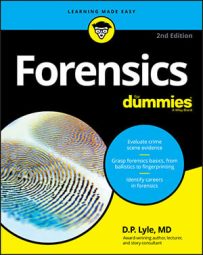If you need to find out how a victim died or identify a piece of a plant found at a crime scene, you call on a forensic scientist trained in pathology or botany, respectively. Professionals who work in the various forensic biological sciences are among the most highly trained and skilled members of the forensics team. They include the following:
Pathologist: A forensic pathologist is a licensed physician with specialty training in pathology, which deals with the nature of disease and the structural and functional changes it causes in the human body. In addition, the forensic pathologist takes subspecialty training in forensic pathology, the application of pathological science to the law.
The forensic pathologist is in charge of the body and all the evidence that is gleaned from its examination. He uses the autopsy, police report, medical records if indicated, suspect and witness interviews, the results of crime lab evidence evaluations, and much more in the pursuit of answers. The forensic pathologist also examines living victims to determine the causes and ages of injuries, particularly in cases of assault, rape, or abuse.
Anthropologist: The forensic anthropologist studies human skeletal remains to determine the age, sex, and race of the deceased, identify any illnesses or injuries that the victim may have suffered, and to estimate the time of death. The forensic anthropologist examines not only the recovered bones, but also the location and circumstances in which they were found. Toxicological, chemical, and DNA analyses also are used by the forensic anthropologist. Other responsibilities may include identifying victims of mass disasters and those interred in mass graves.
Odontologist: A forensic odontologist (or forensic dentist) helps identify unknown corpses by matching dental patterns with previous X-rays, dental casts, or photographs. Because dental enamel is the hardest substance in the human body, forensic dental services can help with identifying homicide victims, victims of mass disasters, and skeletal remains. Forensic odontologists are called upon to match a suspect's teeth with bite marks on the victim or on food products such as cheese or apples.
Entomologist: Entomology is the study of insects. The forensic entomologist uses knowledge of the life cycles of flies and various other insects that feed on corpses to determine the approximate time of death. Likewise, the forensic entomologist uses knowledge of insect habitats to determine whether a body has been moved from one location to another.
Psychiatrist: The forensic psychiatrist may be asked to address someone's sanity or competence to stand trial, sign documents, or give informed medical consent. In suicide cases, forensic psychiatrists may be asked to conduct psychological autopsies to determine possible motivations of the deceased. A forensic psychiatrist may also be asked to provide a psychological profile of an unknown perpetrator.
Serologist: The serology lab deals with blood and other bodily fluids such as saliva and semen, identifying the presence or absence of antigens and antibodies in those fluids. Blood typing, paternity testing, and in some labs even DNA profiling are conducted by the serologist.
Toxicologist: Toxicology is the study of drugs and poisons. The forensic toxicologist determines whether drugs or poisons are present in the living and the deceased, often to assess how those substances contributed to aberrant behavior or death. The forensic toxicologist also determines whether drivers were intoxicated or workers violated company drug-use policies.
Botanist: Examining plant residues, one of the tasks performed by a forensic botanist, is sometimes crucial to solving a crime. Plant fragments, seeds, pollen, and soil may be used to place a suspect at the crime scene. For example, pollen found on the clothing of a suspect can be matched to that of a rural crime scene, thus suggesting that the suspect was in the same area. Plant and pollen evidence also can reveal that a corpse has been moved.

